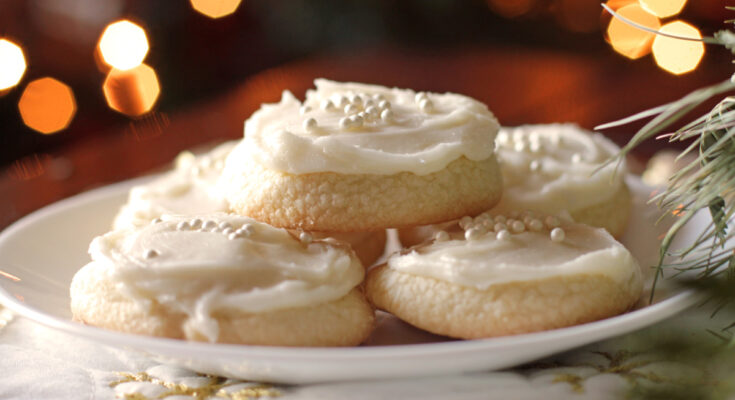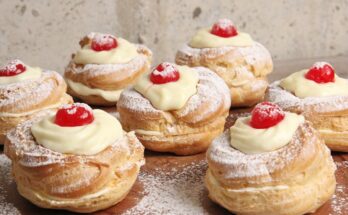Cookie Frosting Recipe: Frosting does more than just make cookies look pretty—it enhances their flavor, adds texture, and brings a festive touch to every batch. Whether you’re baking for holidays, birthdays, or just a fun weekend treat, frosting turns ordinary cookies into eye-catching, irresistible bites of joy. Think about it: would a sugar cookie really be the same without its bright, glossy topping?
Aside from its visual appeal, frosting adds a creamy sweetness that balances the crunch or chew of the cookie. It’s that extra layer of goodness that makes each bite memorable. Plus, the creativity it allows—from colors to designs to themes—is perfect for bakers who love to add a personal touch.
Not to mention, frosted cookies are always a hit at parties. Kids love them, adults admire the artistry, and everyone appreciates the effort behind a beautifully decorated cookie. Whether you’re a newbie or a seasoned baker, mastering cookie frosting is a skill worth learning.
Types of Cookie Frosting
Cookie frosting comes in various forms, each offering its own texture, taste, and decorative potential. Let’s look at some popular types:
- Royal Icing – The go-to for detailed designs, royal icing hardens when dry, making it perfect for intricate decorations and cookie stacking.
- Buttercream Frosting – Creamy, rich, and perfect for a smooth or fluffy finish. Ideal for cookies that will be eaten quickly.
- Glaze Icing – Simple and shiny, glaze is made from powdered sugar and milk or water. It’s great for drizzling or dipping.
- Cream Cheese Frosting – Adds a tangy depth and is wonderful on spiced or pumpkin cookies.
- Fondant – Though not a frosting in the traditional sense, fondant is a pliable sugar dough that can be rolled and cut into shapes for decorating cookies.
Knowing which type suits your cookies best depends on the flavor you’re aiming for and how you plan to decorate.
Ingredients You’ll Need
Basic Ingredients
To whip up a delicious batch of cookie frosting, you don’t need a pantry full of ingredients. In fact, the basics are quite simple. Here’s what you’ll typically need for a standard sugar cookie frosting:
- Powdered Sugar (Confectioners’ Sugar) – The base of most frostings. It dissolves easily and creates that smooth texture.
- Butter (Unsalted) – Adds richness and body to the frosting, especially for buttercream versions.
- Milk or Heavy Cream – Helps achieve the right consistency. More milk means a thinner frosting; less makes it thicker.
- Vanilla Extract – Enhances flavor with a warm, sweet aroma.
These are your essentials. With just these, you can create a basic frosting that’s delicious on its own.
Optional Add-Ins for Flavor and Color
Once you’ve nailed the basics, you can start playing around with add-ins. These take your frosting from simple to spectacular:
- Food Coloring – Gel-based colors are best for vibrant hues without watering down the icing.
- Almond Extract or Lemon Zest – Adds unique flavor notes.
- Cocoa Powder – Mix into the frosting for a rich chocolatey version.
- Sprinkles or Edible Glitter – Not an ingredient per se, but essential for that festive, decorative touch.
The fun part about frosting is how adaptable it is. You can adjust ingredients to suit your cookie type, the occasion, or just your mood.
Tools and Equipment Required
Must-Have Kitchen Tools
To make and apply cookie frosting with ease, having the right tools on hand is crucial. These basic kitchen tools will make the process smooth and stress-free:
- Mixing Bowls – Preferably in different sizes, for mixing and coloring icing.
- Electric Mixer or Hand Whisk – For blending the ingredients into a smooth, fluffy consistency.
- Measuring Cups and Spoons – Precision is key in frosting.
You don’t need anything fancy, but quality tools make a noticeable difference, especially if you’re making large batches.
Tools for Decorative Frosting
If you’re ready to elevate your cookie game, these decorative tools are game-changers:
- Piping Bags – Ideal for applying frosting neatly.
- Piping Tips (Various Shapes) – For creating stars, flowers, lines, and other designs.
- Squeeze Bottles – Great for thinner icings like glazes or royal icing.
- Spatulas and Offset Spatulas – Useful for spreading frosting evenly.
A cookie turntable isn’t essential, but it can help you work more comfortably, especially when decorating multiple cookies at once.
Step-by-Step Cookie Frosting Guide
Step 1: Prepare Your Workstation
Before diving into the frosting itself, set up your space. Clear your countertop, gather all ingredients and tools, and maybe put on a fun playlist—this should be enjoyable!
Line a baking sheet with parchment paper for drying your decorated cookies, and lay out your cooling racks if the cookies are fresh from the oven. Trust us, organizing your space first makes the whole process a breeze.
Also, make sure your cookies are completely cooled before frosting. If they’re even slightly warm, the frosting can melt and slide off.
Step 2: Mix the Ingredients
Let’s get into the fun part—making the frosting! Start by sifting your powdered sugar into a mixing bowl to prevent lumps. This small step makes a big difference in the final texture. Then, add in your softened butter. If you’re making royal icing, you’ll skip the butter and use egg whites or meringue powder instead.
Using a hand mixer or stand mixer, beat the butter and sugar together on low until they begin to combine. Once they do, gradually add your milk or cream, one tablespoon at a time, until the mixture is smooth and creamy. Add a splash of vanilla extract for that classic flavor.
The key here is to go slow. If you add the liquid too quickly, your frosting could become runny. It’s easier to thin out a thick frosting than to thicken a runny one without overloading it with sugar.
Once everything is well-blended and smooth, give it a little taste. Want it sweeter? Add a little more sugar. Need it creamier? Add a splash more milk.
Step 3: Achieve the Right Consistency
Consistency is the secret weapon behind a perfect frosting job. Depending on the cookie and design, you’ll need to adjust the texture of your frosting:
- Thick and Spreadable – Ideal for spreading over soft cookies or using with a spatula. Think sugar cookies with a simple swipe of sweet, buttery frosting.
- Thin and Pipeable – If you’re using piping bags for intricate designs or outlines, your frosting needs to flow but not run.
- Glaze-Like – For dipping or a shiny coating, a thinner consistency is best. It should drip slowly off a spoon.
To thicken, add more powdered sugar a spoonful at a time. To thin it out, add milk or water—just a few drops at a time. Don’t rush. Mix thoroughly before adjusting again. The right consistency not only makes decorating easier but also ensures your frosting sets properly.
Step 4: Add Color and Flavor
Here’s where your creativity can shine! Divide your frosting into separate bowls if you want multiple colors or flavors. Gel food coloring is best because it gives vibrant color without thinning the icing. Start with a toothpick’s worth—you can always add more.
Mix each bowl thoroughly, scraping the sides to ensure even color. If you’re using natural colorings, like beet juice or matcha, just be cautious—they can alter the flavor and texture slightly.
As for flavoring, a few drops of almond extract, peppermint, lemon, or even maple can totally change the experience of your cookies. Just remember: less is more. You want the flavor to complement, not overpower.
Want to get super festive? Add a pinch of cinnamon to your frosting for snickerdoodle vibes, or a splash of espresso for a mocha twist. This is your moment to make your cookies uniquely yours.
Step 5: Apply the Frosting
You’ve made the frosting, colored it, flavored it—now it’s time to bring your cookies to life. Make sure your cookies are completely cool. Even slightly warm cookies will cause the frosting to melt and spread uncontrollably.
If you’re using a piping bag, fill it halfway to avoid mess and allow better control. Twist the top of the bag and practice a bit on parchment paper if you’re new to piping.
For spreading, use an offset spatula or butter knife. Apply a generous dollop and smooth it out gently. If you’re dipping cookies into a glaze, hold them by the edge and dip the top side only. Let the excess drip off before placing them on a rack to dry.
After frosting, you can add sprinkles, candy bits, edible glitter, or any fun toppings you like. But do it quickly—especially if you’re using royal icing or glaze, which set fast.
Let the cookies dry fully before stacking or storing. Royal icing usually takes several hours to harden completely, while buttercream remains soft unless refrigerated.
Tips for Perfect Cookie Frosting
Troubleshooting Common Issues
Even the best bakers run into problems. Here’s how to fix some common frosting frustrations:
- Frosting is too runny? Add more powdered sugar a tablespoon at a time. Mix well after each addition.
- Frosting is too thick? Add a tiny bit of milk or water until you reach the right texture.
- Color too light? Use gel food coloring and add it gradually. Let the color sit—it often deepens after a few minutes.
- Frosting won’t stick to cookies? Make sure the cookies are completely cool and free of excess flour or crumbs.
- Designs are bleeding or spreading? You might be using too much liquid. Try a thicker icing for sharper lines and defined shapes.
The more you practice, the easier it gets. Keep notes on what worked and what didn’t—that way, your next batch will be even better.
Storage and Shelf Life of Frosted Cookies
After all that hard work, you’ll want your cookies to stay perfect for as long as possible. Here’s how to store them:
- Royal Icing Cookies – Let dry completely, then store in an airtight container. They last up to 2 weeks at room temperature.
- Buttercream Frosted Cookies – Best stored in a single layer in airtight containers in the fridge. They’ll stay fresh for 4–5 days.
- Glazed Cookies – Once the glaze hardens, you can stack them carefully in parchment layers inside a container.
If you’re gifting or shipping cookies, go with royal icing or glaze—they’re sturdier and hold up better during transport.
Creative Frosting Ideas for Every Occasion
Holiday-Themed Cookie Frosting
Holidays are the perfect excuse to go all out with your frosting creativity. From red and green Christmas cookies to pastel Easter eggs, themed cookies make every celebration more festive. Use cookie cutters to shape your dough and match your frosting colors and designs accordingly. Add edible gold leaf or shimmer dust for that extra sparkle during New Year’s or wedding events.
For Christmas, try peppermint-flavored icing and add crushed candy canes. Halloween? Go for orange and black frosting with spooky shapes like pumpkins and bats. Fourth of July? Red, white, and blue with star-shaped cookies are always a hit. You can even add edible glitter to elevate the visual appeal.
Want a shortcut? Buy edible markers and draw over set royal icing. It’s a fun activity for kids and makes decorating more interactive.
Frosting for Kids’ Parties
If you’re baking for children’s parties, go bold and bright. Kids love vibrant colors, fun shapes, and sugary toppings. Think unicorn-themed cookies with rainbow frosting or superhero insignias using colored royal icing.
Get them involved in the process—set up a cookie decorating station with bowls of colorful frosting, sprinkles, and edible decorations. Not only does this entertain the little ones, but it also gives them a chance to be part of the creative process.
Use squeeze bottles for better control and less mess. Also, consider allergy-friendly options—using dairy-free butter or natural dyes can help accommodate dietary restrictions.
Advanced Techniques for Decorating
Flooding and Outlining
If you’re ready to level up your cookie decorating game, mastering the “outline and flood” method is essential—especially with royal icing. Here’s how it works:
- Outline – Use thicker icing to draw a border around the cookie. This helps keep the thinner icing inside the lines.
- Flood – Fill the inside with a slightly thinned icing. Use a toothpick to pop bubbles and guide the icing into tight corners.
Let the base layer dry for a few hours, then add another layer for more dimension. This technique is key for creating multi-layered, professional-looking designs.
Marbling and Wet-on-Wet Designs
Marbling is a trendy, eye-catching technique that looks super impressive but is easy to pull off. Use wet-on-wet icing methods to swirl different colors together before they set. Here’s how:
- Pipe lines or dots of contrasting icing into a base layer of still-wet icing.
- Use a toothpick or skewer to gently drag through the icing to create a marble or swirl effect.
It’s perfect for tie-dye cookies, galaxy designs, or floral patterns. The key is working quickly, as royal icing sets fast. Try mixing pastels for Easter, icy blues for winter themes, or neon brights for a retro party vibe.
FAQs about Cookie Frosting Recipe
1. What is the best type of frosting for cookies?
The best frosting depends on your desired texture and flavor. Royal icing is ideal for detailed designs and a smooth, glossy finish. Buttercream offers a creamy, rich taste, while glaze is perfect for quick, sweet coverage.
2. Can I make cookie frosting ahead of time?
Yes, most cookie frostings can be made in advance. Store royal icing in an airtight container at room temperature for up to a week, and buttercream in the fridge for up to a week or freezer for up to 3 months.
3. How do I make frosting that hardens?
To get a frosting that hardens, use royal icing made with meringue powder or egg whites. It dries firm and is great for stacking or packaging cookies.
4. Is there a frosting that doesn’t melt in heat?
Royal icing is your best bet for heat resistance. Avoid frostings made with a high butter content if your cookies will be exposed to warm temperatures.
5. Can I color my cookie frosting?
Absolutely! Use gel food coloring for vibrant shades without altering the frosting’s consistency. Mix well and adjust as needed.
6. Why is my frosting too runny or too thick?
If it’s too runny, add more powdered sugar. If too thick, thin it with milk or water a few drops at a time. Consistency is key, especially for decorating.
7. Is there a dairy-free option for cookie frosting?
Yes! Use plant-based margarine or coconut oil instead of butter, and a non-dairy milk like almond or oat milk. Make sure your powdered sugar is also vegan-friendly.
8. Can I use cookie frosting on cakes or cupcakes?
You can, especially buttercream, but note that royal icing is best suited for cookies due to its drying properties and may not give the desired texture on cakes.
9. How long does frosted cookies last?
Frosted cookies can last up to a week at room temperature in an airtight container. If using royal icing, they can last even longer without losing freshness.
10. Can I freeze cookies with frosting?
Yes, but it depends on the frosting. Buttercream and royal icing freeze well. Let them set fully before layering with parchment paper in an airtight container. Thaw at room temperature.
Conclusion
Cookie frosting isn’t just a sweet topping—it’s a form of edible art that adds excitement, personality, and deliciousness to your cookies. Whether you’re baking for a special occasion or just having fun in the kitchen, learning how to make and use cookie frosting can transform your baking experience.
From choosing the right type of icing and achieving the perfect consistency to experimenting with colors, flavors, and decorative techniques—there’s always something new to try. And the best part? There’s no right or wrong way to do it. It’s about expressing yourself, sharing a treat, and enjoying the sweet little moments in life.
So grab your piping bags, mix up those colors, and start frosting. Your cookies—and your taste buds—will thank you.



